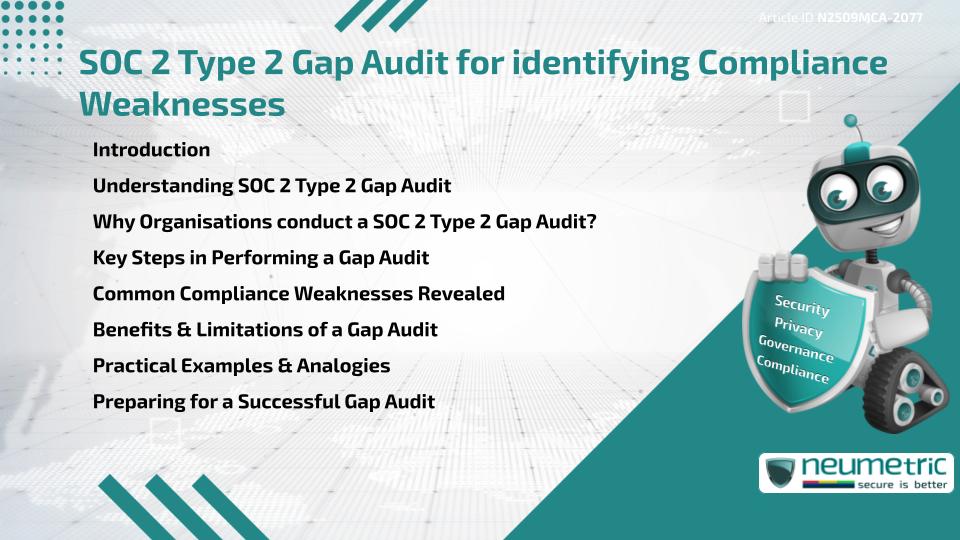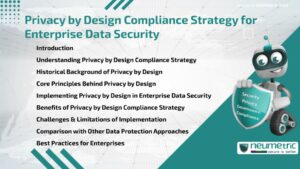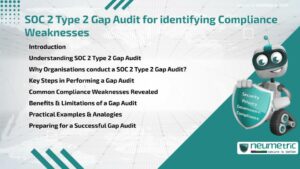Table of Contents
ToggleIntroduction
A SOC 2 Type 2 Gap Audit is a structured process that helps Organisations identify weaknesses in their Compliance with Trust Service Criteria such as Security, Availability, Confidentiality, Processing Integrity & Privacy. By conducting this Audit, companies can highlight areas where Controls are insufficient, uncover Risks that may compromise Compliance & prepare effectively for the official SOC 2 Type 2 examination. The purpose of this article is to explain what a SOC 2 Type 2 Gap Audit involves, why it matters, the steps required, the typical weaknesses it reveals & how Organisations can use it to strengthen Compliance.
Understanding SOC 2 Type 2 Gap Audit
SOC 2 [System & Organisation Controls 2] is a widely recognised Standard developed by the American Institute of Certified Public Accountants [AICPA]. While SOC 2 Type 1 reports assess whether controls are designed effectively at a specific point in time, SOC 2 Type 2 goes further by evaluating whether these controls operate effectively over a defined period, typically between six (6) & twelve (12) months.
A SOC 2 Type 2 Gap Audit serves as a rehearsal for the formal Certification. It provides a diagnostic review to highlight missing Policies, weak Procedures & inconsistent practices before the external Auditors conduct the official Assessment.
Why Organisations conduct a SOC 2 Type 2 Gap Audit?
The primary reason is Risk reduction. A failed SOC 2 Type 2 report can damage Client Trust & hinder Business opportunities. Organisations conduct a SOC 2 Type 2 Gap Audit to:
- Identify control Gaps before the official Audit.
- Save time & costs by correcting issues in advance.
- Demonstrate commitment to Security & Compliance.
- Build confidence with Customers & Partners.
Conducting such audits is especially critical for companies in Cloud Services, SaaS & data-driven industries where Sensitive Information is constantly processed.
Key Steps in Performing a Gap Audit
The SOC 2 Type 2 Gap Audit typically follows a structured approach:
- Scope Definition – Identify which Trust Service Criteria apply.
- Policy Review – Assess existing documentation, such as Access Management & Data Retention.
- Control Evaluation – Verify whether Technical, Physical & Administrative Controls function properly.
- Testing Procedures – Review logs, System activity & Employee practices.
- Reporting Findings – Document areas of strength & weakness & recommend remediation actions.
Common Compliance Weaknesses Revealed
A SOC 2 Type 2 Gap Audit often uncovers recurring issues. These include:
- Weak Access Controls – Employees with unnecessary or outdated system privileges.
- Incomplete Logging – Insufficient records of Security events.
- Policy Gaps – Outdated or missing documentation of key processes.
- Vendor Oversight – Inadequate monitoring of Third Party Service Providers.
- Employee Training Gaps – Staff unaware of Compliance protocols.
Each weakness, if left unresolved, can cause control failures during the actual Type 2 Audit.
Benefits & Limitations of a Gap Audit
The benefits of a SOC 2 Type 2 Gap Audit are clear. Organisations gain visibility into their Compliance status, reduce surprises in the official Audit & create a roadmap for remediation. Additionally, it fosters a culture of accountability across teams.
However, there are limitations. A Gap Audit does not provide a final certification. It may also be influenced by the expertise of the auditor conducting it. Furthermore, without organisational buy-in, identified weaknesses may remain unresolved despite the Audit.
Practical Examples & Analogies
Think of a SOC 2 Type 2 Gap Audit as a mock exam before a final test. Just as students practice with trial papers to identify where they fall short, Organisations use Gap audits to highlight Compliance areas that need strengthening. Another analogy is a car inspection before a long trip — addressing small repairs early prevents costly breakdowns later.
Preparing for a Successful Gap Audit
Preparation is as critical as execution. Organisations should:
- Assign internal champions for each Trust Service Criterion.
- Update & centralise Compliance documentation.
- Provide training for Employees on Security practices.
- Conduct internal checks before the external Gap Audit begins.
Takeaways
- A SOC 2 Type 2 Gap Audit identifies Compliance weaknesses early.
- It strengthens internal Controls & documentation.
- Organisations gain Confidence before the Official Audit.
- It improves Trust with Customers & Partners.
- A Gap Audit is a strategic tool, not just a formality.
FAQ
How is a SOC 2 Type 2 Gap Audit different from a Readiness Assessment?
A Gap Audit specifically identifies existing weaknesses in controls, while a Readiness Assessment provides a broader overview of preparedness.
Who should conduct a SOC 2 Type 2 Gap Audit?
It is best conducted by experienced Auditors with knowledge of SOC 2 criteria & organisational processes.
How frequently should Organisations perform a SOC 2 Type 2 Gap Audit?
Ideally, once before each Certification cycle to ensure no weaknesses go unnoticed.
Does a SOC 2 Type 2 Gap Audit guarantee Compliance?
No, it highlights weaknesses but does not replace the formal Certification Process.
What industries benefit most from a SOC 2 Type 2 Gap Audit?
SaaS Providers, Cloud Service companies & businesses handling sensitive Customer Data benefit the most.
Need help for Security, Privacy, Governance & VAPT?
Neumetric provides organisations the necessary help to achieve their Cybersecurity, Compliance, Governance, Privacy, Certifications & Pentesting needs.
Organisations & Businesses, specifically those which provide SaaS & AI Solutions in the Fintech, BFSI & other regulated sectors, usually need a Cybersecurity Partner for meeting & maintaining the ongoing Security & Privacy needs & requirements of their Enterprise Clients & Privacy conscious Customers.
SOC 2, ISO 27001, ISO 42001, NIST, HIPAA, HECVAT, EU GDPR are some of the Frameworks that are served by Fusion – a SaaS, multimodular, multitenant, centralised, automated, Cybersecurity & Compliance Management system.
Neumetric also provides Expert Services for technical security which covers VAPT for Web Applications, APIs, iOS & Android Mobile Apps, Security Testing for AWS & other Cloud Environments & Cloud Infrastructure & other similar scopes.
Reach out to us by Email or filling out the Contact Form…





